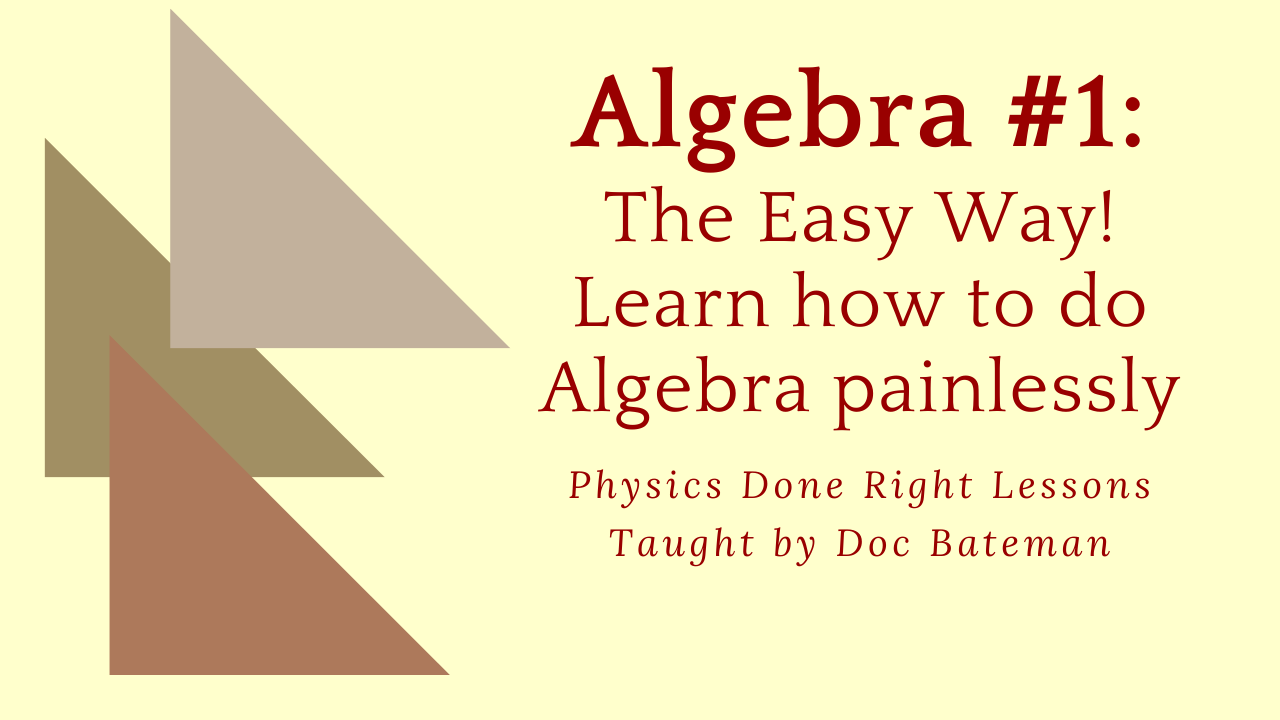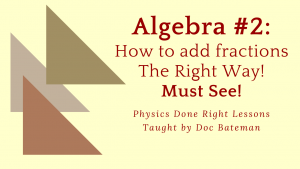A math refresher on Algebra, Part 1.
Easier techniques for solving an equation for a certain variable. What are variables, how to use them, what they represent. Be sure to get your free worksheet that goes with this video!
Transcript
Hi there, Doc Bateman here. Before we get started in physics, we need to spend a little time making sure that everyone is up to speed on Algebra. In this lesson, I will take you through a review of the basics and teach you a new and easier way. I want you to be able to solve equations without having to think too much about it. If you get value from my videos, please like and subscribe below. Then you’ll get a notification when I publish new videos. And please, share them with a friend. Leave me questions in the comments below. Let’s get started.
Here is a basic Algebra refresher. How well do you know algebra? For physics, you need to be solid in it. Here I will show you (maybe) a different way of thinking about it. The main thing with algebra is to keep everything balanced and you think of the equals sign as the balance point.
We start by talking about variables. What are variables? A variable is something that stands for something else. A variable can represent a number, it can represent a bunch of other variables, or it can represent a function — something that changes with time. How to use a variable? Anytime there is something that you don’t know, something that you’re trying to look for, or solve for, you let it be represented by a variable, and then you solve for that variable. In this video, we will use lowercase letters as variables. In Physics, we typically use lowercase and uppercase English letters and lowercase and uppercase Greek letters. But here, we’ll just use regular lowercase alphabet letters.
What does it mean when you are asked to solve for x? What that means is you want x all by itself on the left hand side of the equation, so your equation says x = everything else you’ve solved for.
Let’s start by talking about addition and subtraction. So here’s an equation a + b + c = d and we’re being asked to solve for a. The way you’ve probably been shown to do this is: subtract b from both sides and now we have a + b – b + c = d – b. The b‘s cancel, and we’re left with a + c = d – b. So now we still need to isolate a so we subtract c from both sides and we get a + c – c = d – b – c. I’m left with a = d – b – c.
And now we come to what I call rule #1 for added terms as they cross the equal sign they change sign: Positive becomes negative, and negative becomes positive. So if we go back and look at that example we see that as the b crossed it became negative and as the c crossed it became negative. So what if we just do it that way? Call this the new way. I want to isolate a, so that means the b and c terms, as they go across the equals sign, need to become negative. So start by writing a =, then I have the d we began with, minus b minus c, and I’m done. I have solved for a.
Let’s do another example. We want to solve for a so everything that is not a goes to the other side of the equation. That means all of the other terms here have to go to the other side of the equation. I start by writing a =. I have an 8 to begin with, so the 8 comes across as a -8. The –f comes across as +f and g comes across as –g, and I’m done.
Now let’s talk about multiplication and division. In this equation a * b * c = d, we’re asked to solve for a. Again that means we have to isolate a. So for the old way of doing this, I need to divide through by b, the b‘s cancel, and I’m left with a * c = d / b. Now I have to divide through by c and what I’m left with is a = d / (b * c).
Now my rule #2: for multiplied terms, as you cross the equals sign, top goes to bottom, and bottom goes to top. Let’s go back and look at that. So the b and the c were in the numerator of the fraction and as it goes across the equals sign becomes the denominator of the fraction. So b and c went from top to bottom, so I’m left with d / (b * c).
Let’s rework this the new way. I have the b and the c term here that I need to move, and because they’re in the numerator they need to cross the = into the denominator. So that means I simply can write a = d /(b * c) and I’m done. Top goes to bottom and bottom goes to top.
Here’s a more complicated equation! I have 9 * r * s / (t * v) = b * c, and I want to solve for r. In the numerator, I have 9 and s that need to move across, they’re in the numerator. Start with r = . I have b and c in my numerator, so the 9 and s need to come from top to bottom, so I can just write them in the denominator. Next I have t and v in the denominator, so when they come across, they move into the top (bottom goes to top). So there we have it; my final answer r = b * c * t * v / 9 * s.
Now let’s put our two rules together. So in this equation we have to deal with additive terms and multiplied terms. In this equation, we were asked to solve for b, so we need to isolate the term that contains b. So let’s write it by itself: 3 * b * c / d = and then write the term that’s already there 3x * z. Now we have a 2g that needs to come across the equals sign so it becomes -2g and then we have a -4a and when it comes across it becomes +4a. So now, in order to solve for b we have to move the 3 and the c and the d across the equals sign, so write b = , that’s what we’re solving for. Here’s what we have 3x*z – 2*g + 4*a. The 3 and the c come to the bottom so we write it in the denominator and then the d comes to the top. The d has to be multiplied by the whole thing, so we put on parentheses and write a d and that’s done. We’ve solved for b. So the summary of this is: you need to distinguish between added (or subtracted) terms and multiplied (or divided) terms. When a term crosses the equals sign, the added terms change sign and for the multiplied terms, top goes to bottom and bottom goes to top.
There you have my review on solving equations. I hope this helped you to do Algebra a little more easily. The next part will be about dealing with fractions. Don’t miss it! If you get value from my videos, please like and subscribe below. Then you’ll get a notification whenever I publish a new video. And please, share them with a friend. Leave me questions in the comments below. Thanks for watching.



